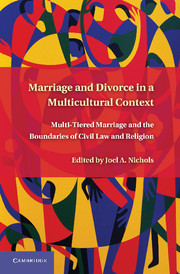 Marriage and Divorce in a Multi-Cultural Context
Marriage and Divorce in a Multi-Cultural Context A Model for Compromise
Published online by Cambridge University Press: 05 November 2011
Three American states – Louisiana, Arizona, and Arkansas – statutorily authorize couples to enter into a “covenant marriage.” These covenant marriage statutes incorporate into law, in varying degrees, the understanding of traditional marriage as historically recognized in Western countries – a sexually monogamous union between one man and one woman intended to be for life. Further, covenant marriage attempts to lessen the problems of divorce by strengthening the institution of marriage. John Witte explains the logic well:
The Western tradition has learned, through centuries of experience, to balance the norms of marital formation, maintenance, and dissolution.… The lesson in this is that rules governing marriage formation and dissolution must be comparable in their stringency. … Loose formation rules demand loose dissolution rules, as we see today. To fix “the modern problem of divorce” will require reforms of rules at both ends of the marital process.
What is covenant marriage?
Covenant evokes a rich heritage both in the law, as a special form of contract with specific formalities and greater binding force, and in religion, as an unbreakable and perpetual agreement between the Creator and mankind. The word covenant added as an adjective preceding marriage carries with it that rich heritage from dual sources to imbue and renew our understanding of a very old, yet indispensable, social institution. As Max Stackhouse describes a covenant’s effect:
[t]he sociotheological idea of covenant is so rich with ethical content that it gives moral meaning to all it touches.… [A] covenant shifts the terms of … relationships. [A covenant] is not cut casually, for it entails not only celebration and sacrifice but also the incorporation of new shared duties and rights that nourish life with other meanings, and thus a sense that these duties and rights are based on an enduring law and purpose as established by a higher authority.
To save this book to your Kindle, first ensure no-reply@cambridge.org is added to your Approved Personal Document E-mail List under your Personal Document Settings on the Manage Your Content and Devices page of your Amazon account. Then enter the ‘name’ part of your Kindle email address below. Find out more about saving to your Kindle.
Note you can select to save to either the @free.kindle.com or @kindle.com variations. ‘@free.kindle.com’ emails are free but can only be saved to your device when it is connected to wi-fi. ‘@kindle.com’ emails can be delivered even when you are not connected to wi-fi, but note that service fees apply.
Find out more about the Kindle Personal Document Service.
To save content items to your account, please confirm that you agree to abide by our usage policies. If this is the first time you use this feature, you will be asked to authorise Cambridge Core to connect with your account. Find out more about saving content to Dropbox.
To save content items to your account, please confirm that you agree to abide by our usage policies. If this is the first time you use this feature, you will be asked to authorise Cambridge Core to connect with your account. Find out more about saving content to Google Drive.